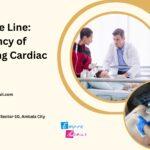Cardiac arrest can be a frightening term, but it’s essential to know what it means, how it differs from a heart attack, and what to do if it happens. In this article, we will break down the basics of heart arrest, explore the distinctions between a heart attack and heart arrest, and discuss common symptoms and treatments.
What is Cardiac Arrest?
Cardiac arrest occurs when the heart suddenly stops beating. This can happen to anyone, anywhere, and at any time. When the heart stops, blood is no longer pumped to the rest of the body, and immediate action is needed to save a person’s life.
Differences Between Heart Attack and Cardiac Arrest:
Heart Attack: A heart attack happens when blood flow to a part of the heart muscle is blocked. It’s like a traffic jam in the blood vessels. The heart is still pumping, but part of it isn’t getting the blood it needs.
Cardiac Arrest: In contrast, cardiac arrest is when the heart stops pumping altogether. It’s like the engine of a car suddenly shutting down. No blood is circulating in the body.
Symptoms of Cardiac Arrest:
Recognizing the signs of cardiac arrest is crucial for prompt action. Common symptoms include:
- Sudden loss of responsiveness.
- Absence of normal breathing or gasping.
- No pulse or heartbeat.
Treatment for Cardiac Arrest:
Cardiac arrest is a medical emergency that requires prompt intervention to increase the chances of survival. Here’s a step-by-step guide to the treatment of cardiac arrest:
Call for Help:
The first and most crucial step is to call emergency services immediately. Time is of the essence in a heart arrest situation.
Initiate CPR (Cardiopulmonary Resuscitation):
1. If the person is unresponsive and not breathing normally, start CPR right away.
2. Place the heel of your hand on the center of the person’s chest and push hard and fast (at least 2 inches deep and at a rate of 100-120 compressions per minute).
3. Continue CPR until professional help arrives or the person starts breathing on their own.
Use of Automated External Defibrillator (AED):
- If an AED is available, use it as soon as possible. AEDs are user-friendly devices that can analyze the heart’s rhythm and deliver an electric shock if needed.
- Follow the AED’s voice prompts and instructions for optimal use.
Administer Medications:
Emergency medical personnel may administer medications to support heart function and restore a normal heart rhythm.
Advanced Life Support (ALS):
Paramedics and emergency medical teams provide advanced life support measures, including intravenous medications and advanced airway management, to stabilize the person.
Transfer to the Hospital:
Once the person’s condition is stabilized, they will be transferred to the hospital for further evaluation and treatment.
Post-Resuscitation Care:
Survivors of heart arrest may require intensive care and monitoring to prevent complications and optimize recovery.
Rehabilitation and follow-up care are essential for a full recovery.
Conclusion:
Understanding the basics of heart arrest, differentiating it from a heart attack, recognizing symptoms, and knowing how to respond can make a significant difference in saving lives. Remember, quick action is crucial in the face of heart arrest, and being informed empowers everyone to act effectively in an emergency.








